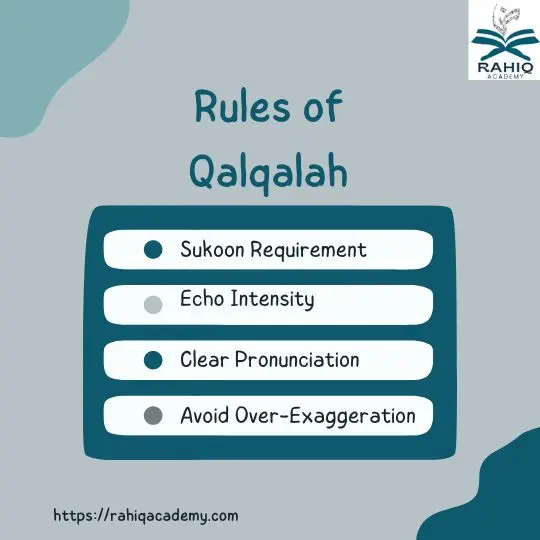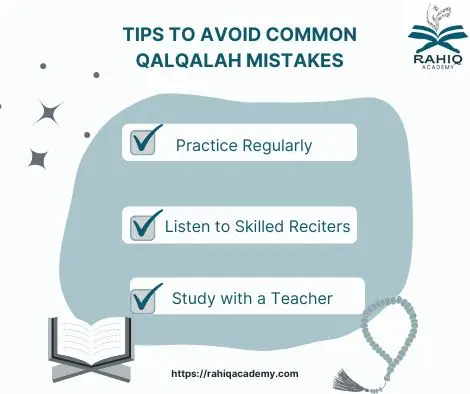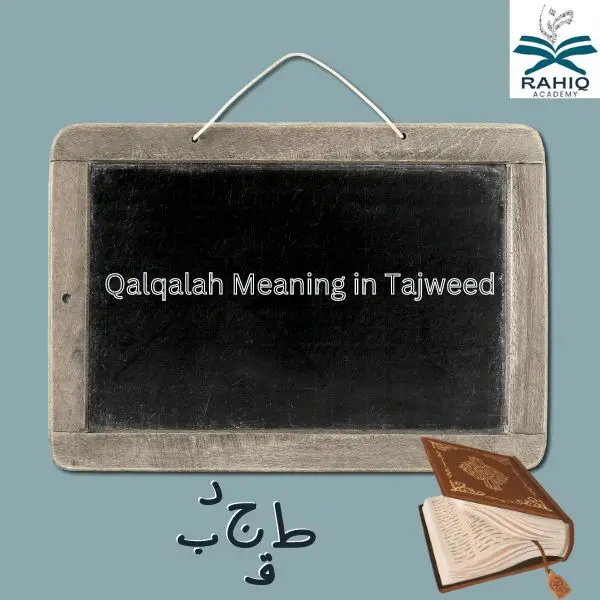In the study of Tajweed, the rules that guide the proper pronunciation and recitation of the Quran, Qalqalah plays a crucial role. This concept refers to an echoing or bouncing sound that is produced when specific Arabic letters are recited. Mastering Qalqalah is essential for maintaining the clarity and correct pronunciation of the Quran, ensuring that the recitation is smooth and accurate. This guide will discuss qalqalah meaning in Tajweed, the relevant letters, the different types, the rules for applying it, and common mistakes, along with practical examples.
What Is Qalqalah in Tajweed?
Qalqalah (قلقلة) is a Tajweed rule that creates a bouncing or echoing sound when pronouncing five specific Arabic consonants. These consonants are:
- ق (Qaaf)
- ط (Taa)
- ب (Baa)
- ج (Jeem)
- د (Daal)
The bouncing sound occurs when these letters are pronounced with a sukoon (when they are not followed by a vowel), ensuring their clarity and preventing any mispronunciation. The Quran emphasizes the importance of proper recitation:
“وَرَتِّلِ ٱلۡقُرۡءَانَ تَرۡتِيلًۭا”
“And recite the Quran with measured recitation.”
— Surah Al-Muzzammil (73:4)
This verse highlights the significance of following Tajweed rules, including Qalqalah, to ensure that the recitation is done correctly and with precision.
Qalqalah Letters in Arabic
The Qalqalah letters in Arabic are the backbone of this Tajweed rule. Each letter produces a unique sound that must be properly articulated. The mnemonic “قطب جد” (Qutb Jad) is often used to remember these five letters:
1-Qaf letter:
{إِنَّا جَعَلْنَا فِي أَعْنَاقِهِمْ أَغْلالاً فَهِيَ إِلَى الأَذْقَانِ فَهُم مُّقْمَحُونَ}.
{وَخَلَقْنَا لَهُم مِّن مِّثْلِهِ مَا يَرْكَبُونَ}.
{أَوَلَمْ يَرَوْا أَنَّا خَلَقْنَا لَهُمْ مِمَّا عَمِلَتْ أَيْدِينَا أَنْعَامًا فَهُمْ لَهَا مَالِكُونَ}.
2-Taa letter:
{وَإِذَا قِيلَ لَهُمْ أَنفِقُوا مِمَّا رَزَقَكُمْ اللهُ قَالَ الَّذِينَ كَفَرُوا لِلَّذِينَ آمَنُوا أَنُطْعِمُ مَن لَّوْ يَشَاء اللهُ أَطْعَمَهُ إِنْ أَنتُمْ إِلاَّ فِي ضَلالٍ مُّبِينٍ}.
{أَوَلَمْ يَرَ الإِنسَانُ أَنَّا خَلَقْنَاهُ مِن نُّطْفَةٍ فَإِذَا هُوَ خَصِيمٌ مُّبِينٌ}.
{إِذْ قَالَتِ امْرَأَةُ عِمْرَانَ رَبِّ إِنِّي نَذَرْتُ لَكَ مَا فِي بَطْنِي مُحَرَّرًا فَتَقَبَّلْ مِنِّي إِنَّكَ أَنتَ السَّمِيعُ الْعَلِيمُ}.
3-Baa letter:
{وَجَعَلْنَا مِن بَيْنِ أَيْدِيهِمْ سَدًّا وَمِنْ خَلْفِهِمْ سَدًّا فَأَغْشَيْنَاهُمْ فَهُمْ لاَ يُبْصِرُونَ}.
{وَاضْرِبْ لَهُم مَّثَلاً أَصْحَابَ الْقَرْيَةِ إِذْ جَاءَهَا الْمُرْسَلُ
{سُبْحَانَ الَّذِي خَلَقَ الأَزْوَاجَ كُلَّهَا مِمَّا تُنبِتُ الأَرْضُ وَمِنْ أَنفُسِهِمْ وَمِمَّا لا يَعْلَمُونَ}.
{رَبَّنَا لاَ تُزِغْ قُلُوبَنَا بَعْدَ إِذْ هَدَيْتَنَا وَهَبْ لَنَا مِن لَّدُنكَ رَحْمَةً إِنَّكَ أَنتَ الْوَهَّابُ}.
4-Jeem letter:
{إِنَّمَا تُنذِرُ مَنِ اتَّبَعَ الذِّكْرَ وَخَشِيَ الرَّحْمَن بِالْغَيْبِ فَبَشِّرْهُ بِمَغْفِرَةٍ وَأَجْرٍ كَرِيمٍ}.
{وَآيَةٌ لَّهُمُ الأَرْضُ الْمَيْتَةُ أَحْيَيْنَاهَا وَأَخْرَجْنَا مِنْهَا حَبًّا فَمِنْهُ يَأْكُلُونَ}.
{وَالشَّمْسُ تَجْرِي لِمُسْتَقَرٍّ لَّهَا ذَلِكَ تَقْدِيرُ الْعَزِيزِ الْعَلِيمِ}.
{قُلْ أَؤُنَبِّئُكُم بِخَيْرٍ مِّن ذَلِكُمْ لِلَّذِينَ اتَّقَوْا عِندَ رَبِّهِمْ جَنَّاتٌ تَجْرِي مِن تَحْتِهَا الأَنْهَارُ خَالِدِينَ فِيهَا وَأَزْوَاجٌ مُّطَهَّرَةٌ وَرِضْوَانٌ مِّنَ اللهِ وَاللهُ بَصِيرٌ بِالْعِبَادِ}.
5-Dal letter:
{لَقَدْ حَقَّ الْقَوْلُ عَلَى أَكْثَرِهِمْ فَهُمْ لا يُؤْمِنُونَ}.
{أَأَتَّخِذُ مِن دُونِهِ آلِهَةً إِن يُرِدْنِ الرَّحْمَن بِضُرٍّ لاَّ تُغْنِ عَنِّي شَفَاعَتُهُمْ شَيْئًا وَلاَ يُنقِذُونِ}.
{قِيلَ ادْخُلِ الْجَنَّةَ قَالَ يَا لَيْتَ قَوْمِي يَعْلَمُونَ}.
Types of Qalqalah
There are three levels or types of Qalqalah, depending on the position of the letter in a word and the intensity of the echoing sound:
1. Level 3 – Strong Qalqalah (Qalqalah Kubra)
Strong Qalqalah occurs when a Qalqalah letter appears at the end of a word, especially when it has a shaddah (doubled consonant), and the reciter stops (waqf). In this case, the echo is pronounced and strong. This type of Qalqalah is most noticeable at the end of verses.
Examples:
- “تَبَّتۡ يَدَآ أَبِي لَهَبٖ وَتَبَّ”
“May the hands of Abu Lahab be ruined, and ruined is he.”
— Surah Al-Masad (111:1) - “قُلۡ هِيَ مَوَٰقِيتُ لِلنَّاسِ وَٱلۡحَجِّ”
“Say, ‘They are times appointed for the people and for Hajj.'”
— Surah Al-Baqarah (2:189) - “وَجَآءَتۡ سَكۡرَةُ ٱلۡمَوۡتِ بِٱلۡحَقِّ”
“And the intoxication of death will bring the truth.”
— Surah Qaf (50:19)
2. Level 2 – Medium Qalqalah (Qalqalah Wusta)
Intermediate Qalqalah occurs when a Qalqalah letter is at the end of a word but does not have a shaddah. The echo is present but less intense than Qalqalah Kubra.
Examples:
- “وَٱللَّهُ مِن وَرَآئِهِم مُّحِيطٌۢ”
“And Allah is surrounding them from behind.”
— Surah Al-Buruj (85:20) - “مَآ أَغۡنَىٰ عَنۡهُ مَالُهُۥ وَمَا كَسَبَ”
“His wealth will not avail him nor what he earned.”
— Surah Al-Masad (111:2)
3. Level 1 – Weak Qalqalah (Qalqalah Sughra)
Weak Qalqalah occurs when a Qalqalah letter appears in the middle of a word, or when the reciter does not stop. The echo is softer and brief, but still necessary for clear pronunciation.
Examples:
- “فَٱلۡيَوۡمَ لَا تُظۡلَمُ نَفۡسٞ شَيۡـٔٗا”
“So today no soul will be wronged at all.”
— Surah Ya-Sin (36:54) - “وَخَلَقۡنَٰكُمۡ أَزۡوَٰجٗا”
“And We created you in pairs.”
— Surah An-Naba (78:8)
Rules of Qalqalah

To apply Qalqalah correctly, several key rules of Qalqalah must be observed:
- Sukoon Requirement: Qalqalah occurs only when a Qalqalah letter carries a sukoon or when stopping at the letter.
- Echo Intensity: The strength of the echo depends on whether the reciter stops (Qalqalah Kubra) or continues (Qalqalah Sughra).
- Clear Pronunciation: The echo should be clear and distinct, ensuring the letter is properly articulated.
- Avoid Over-Exaggeration: The echo should not be exaggerated, as this disrupts the natural flow of the recitation.
Common Qalqalah Mistakes
When learning Qalqalah, it is common to make a few mistakes. Here are some frequent errors and tips on how to avoid them:
- Over-Exaggeration: Excessively pronouncing the echo can make the recitation sound unnatural.
- Neglecting the Echo: Failing to apply Qalqalah where needed can reduce the clarity of the recitation.
- Misapplying Qalqalah: Qalqalah should only be applied to the five designated letters. Applying it to other letters results in incorrect recitation.
Tips to Avoid common Qalqalah Mistakes

Here are some practical tips to avoid common Qalqalah mistakes:
- Practice Regularly: Recite verses with Qalqalah letters and get feedback from a teacher or experienced reciter.
- Listen to Skilled Reciters: Listening to proficient reciters will help you understand how to apply Qalqalah correctly.
- Study with a Teacher: Learning Tajweed with a knowledgeable teacher ensures you apply the rules correctly and avoid bad habits.
Conclusion
Qalqalah is an important Tajweed rule that adds clarity and precision to Quranic recitation. By mastering its application, you can improve your recitation’s accuracy and flow.
At Rahiq Academy, we offer comprehensive Online Tajweed Courses to help students of all levels understand and apply the rules of Qalqalah and other Tajweed principles.
If you or your children would like to deepen your understanding of Tajweed, including the proper use of Qalqalah, join our Online Tajweed Course at Rahiq Academy.




